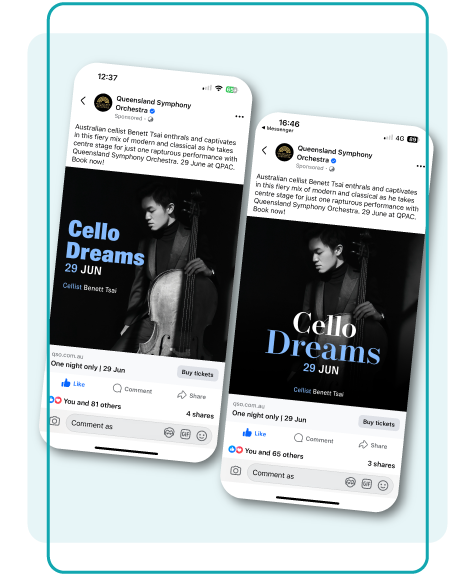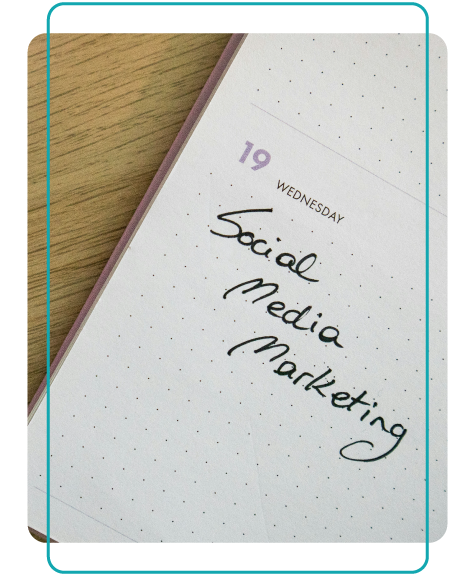Let’s face it – budgets are tight.
Whether you’re agency-side or in-house, marketers are all facing the same question: how do we do more with less? When it comes to budget cuts, brand marketing is often the first thing to go. It’s harder to track, tricky to tie directly to ROI, and doesn’t appear to offer the immediate wins performance marketing does.
But here’s the thing – treating brand and performance like exclusive choices is the wrong move. They’re two sides of the same coin – and the real magic happens when they work together.
Your performance thrives when it’s backed by brand.


what is brand marketing?
Brand marketing is all about crafting a strong identity, building awareness and creating an emotional connection with customers through storytelling. It’s a long-term effort which, when done effectively (and consistently) over time, is the answer to brand equity, consumer trust and loyalty.
Nike, Vegemite, Airbnb and even newcomers like July Luggage- the most memorable and iconic brands have all got brand marketing down to a fine art.
But here’s the catch: it’s harder to measure. Unlike performance marketing, there’s no instant hit of ROI. Building a brand takes time. So, when budgets tighten, brand activity is often the first to go.
why brand marketing is important
Despite this brand marketing is an essential component of a well-rounded marketing strategy (if building a brand is your objective) and when implemented consistently brings value in the form of:
- Brand Awareness – You can’t be a go-to if no one knows you exist. You need your target audience to recognise your brand and remember what is stands for it.
- Brand Image – Want to be seen as cool, innovative or reliable? Brand storytelling is how you shape public perception of your brands desirable qualities
- Increased Brand Equity – Never tried a coffee pod before? You’re probably reaching for Nespresso over Pod Co. That’s equity at work. The added value that having a recognisable and respected brand has on buying decisions.


- Emotional Connection – Humans are driven by their emotions, and emotional connections have lasting impacts on favourability, loyalty and purchase decisions.
- Trust, Credibility and Loyalty – Consistency, recognisability and favourability build trust and credibility, which in turn encourages loyalty.
- Differentiation – Good brand marketing not only helps communicate your differentiation from your competitors, but in oversaturated spaces, compelling storytelling could be your differentiation.
- Justified Price Points – With clear positioning and values, brands can justify higher price points – just look at the Hermes Birkin advertising on digital platforms like Spotify or Amazon Prime
- Longevity/Customer Lifetime Value (CLV) – Brand marketing activities won’t deliver results overnight, but they’re building blocks of a sustainable brand that sees customers returning time and time again.
what is performance marketing?
Performance marketing is measurable, trackable and outcome focused. It’s all about getting clicks, conversions, leads and installs – and knowing exactly how much it cost you to get them.
John Wanamaker once said, “Half the money I spend on advertising is wasted; the trouble is I don’t know which half” and for more than a century marketers echoed this frustration.
Now, thanks to performance marketing – we finally do.


why performance marketing is important
- Measurable ROI – You know exactly where your money’s going and what it’s doing. With performance marketing, every click, view, and conversion can be tracked and reported – making it easier to prove impact and optimise spend.
- Highly Targeted – You can get really specific – we’re talking “recently searched for adjustable dumbbells and lives within 5km of a Kmart” specific. You can tailor your message by audience interests, behaviours, demographics, and more, ensuring your ads land in front of the right people at the right time.
- Scalable – Campaign that’s killing it? Great, pour fuel on that fire. Performance is flexible and easy to scale, so you can test with a small budget and increase investment once you’ve found your winners.
- Cost Effective – Not necessarily cheap, but certainly efficient. You’re directly paying for actions (clicks, conversions, installs) so every dollar is accountable for. For tighter budgets, this makes performance marketing a smart investment.
- Real-time Optimisation – Performance marketing isn’t set-and-forget – if something’s not working, you tweak and optimise in real time.
- Room for Experimenting – A/B testing is a big part of performance marketing. Test headlines, creative, audiences, landing pages – learn fast and apply it.
- Outcome Based – At its core, performance marketing is results-driven. Every campaign starts with a goal. There’s no fluff – just focused activity that delivers on specific business objectives.


finding the balance between performance and brand
As you may have guessed, we strongly support the idea that this isn’t brand vs performance – it’s brand AND performance. When combined, they create a feedback loop that amplifies both. After all no-one is looking for a Kmart within 5km if they don’t know the brand.
Too often businesses swing the pendulum too far toward performance – it’s measurable, immediate, and easy to justify to the CFO. But drop brand marketing entirely and you’re left with ads that work… until they don’t.
A strong marketing strategy blends the two.
why performance and brand marketing work best together
- Brand makes performance work harder – Once brand marketing has done the heavy lifting – building recognition, emotional connection and trust – performance marketing becomes significantly more likely to convert.
- Performance without brand is risky – Performance–focused campaigns that don’t take brand strategy into account can damage the brand image long-term.
- It’s a snowball effect – Awareness fuels performance. Performance data informs branding. And strong branding improves conversion. When done well, the two disciplines create a loop that lifts results on both sides.
- Brand messaging actually outperforms performance messaging – According to Analytic Partners, campaigns that lead with brand messaging outperform those with purely performance-focused messaging 80% of the time. Yes, even when the goal is conversion.
- Brand for longevity. Performance for short–term goals – Brand marketing is about future-proofing the business – building loyalty, equity and emotional connection. Performance marketing focuses on short-term sales, growth, and lead generation. One protects your future, the other funds it.


how marketers can manage the trade off
1. Build awareness, trust and equity through brand
Start by investing in your identity, positioning and storytelling. Know your audience deeply and commit to showing up consistently with a message that matters to them. Building a brand takes time – but it lays the foundation for everything that follows.
2. Layer in performance once you’ve earned attention
Once brand marketing has created recognition and interest, performance marketing can step in to convert. Retargeting warm audiences, promoting offers, and guiding users to action becomes far more effective when there’s already familiarity in place.
→ Hot tip: Your organic social media presence is often where early brand trust is formed (with no $ investment needed). Then, once your audience is already engaging with you organically, it’s the perfect springboard for a paid retargeting campaign.
3. Make brand measurable
While harder to track, it’s not impossible – you just need to reframe the KPIs. Track metrics like branded search volume, social listening sentiment, direct traffic growth, share of voice, follower growth, and email subscriber quality. These indicators show how your brand is resonating – even if they don’t tie directly to an immediate sale.
4. Diversify your touchpoints
The real power play? Taking an omnichannel approach where both brand and performance campaigns show up across multiple platforms and formats – reinforcing each other.
→ Hot Tip: We don’t want to brag, but brindle are the experts on omnichannel, crafting cross-platform campaigns that work synergistically is kind of our jam.


how to split the budget between performance and brand
Never go all-in on one
Whether you’re selling socks or software, focusing solely on brand OR performance is short-sighted. A smart split keeps you winning today while building for tomorrow.
Your ideal split depends on your business
E-comm, SaaS, local services and lead gen brands often lean heavily on performance. Luxury, CPG, finance and tech brands usually need to invest more in brand equity.
Context matters too
Sales cycle, business stage, budget, target audience and goals all influence your mix. Startups may prioritise performance for traction. Mature brands might double down on brand.
A baby formula brand, with price-sensitive consumers, may see better results from a performance-heavy strategy. While a Gen Z focused skincare will likely see wins from an enhanced brand image.
So, what does the split look like?
- An 80/20 performance to brand split works for fast-paced eComm or promo-driven brands.
- 60/40 brand to performance, from Binet & Field’s research, delivers the best long-term results.
- A 50/50 split suits brands with pre-established, steady awareness and lead-gen needs.
The takeaway? Follow your data, there’s no perfect ratio, but a balanced, evolving strategy beats a one-track mindset every time.
Want help finding your brand–performance sweet spot? Brindle’s your partner in building modern, balanced marketing strategies – contact us today for an introductory chat.
